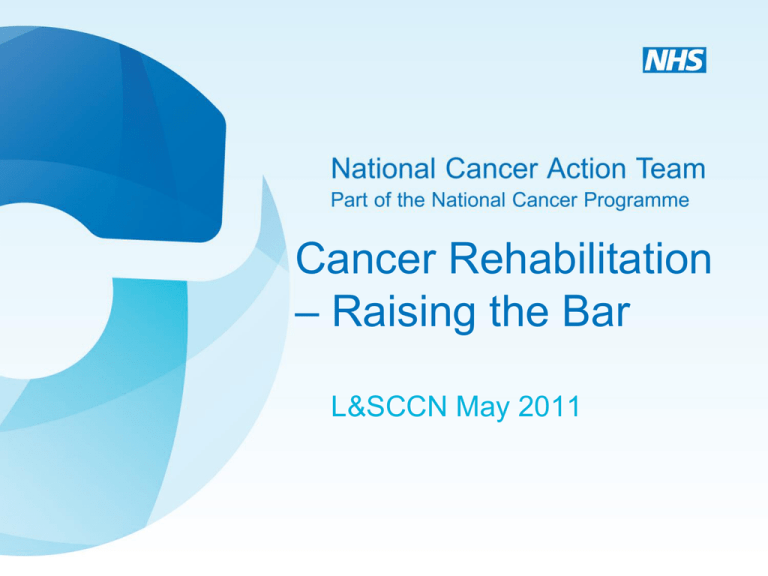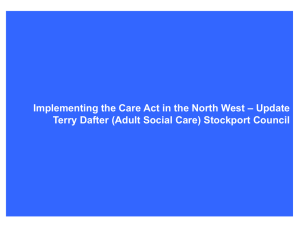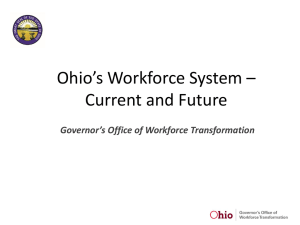Jackie Turnpenney
advertisement

Cancer Rehabilitation – Raising the Bar L&SCCN May 2011 Introduction • The challenges of cancer rehabilitation • The vision • National Cancer Rehabilitation Advisory Board – Care pathways – Workforce model – Education, training and workforce development – New work Is there a need for change? • 2 million living with and beyond cancer in UK – 1.6 m completed therapy – Prevalence increases by 3.2% p.a. – 4 million in 20 years • 20 million (1:3) people are living with a long term condition Click to add title “Today, talking about cancer is no longer taboo and, thanks to brilliant research and amazing clinical advances, we are likely to know more people living with cancer than dying from it” Professor Steve Field, Chair RCGP (HSJ) The Challenges of Cancer Rehabilitation • Rehabilitation is not understood by many people especially in relation to cancer – patients, commissioners, GPs, other AHPs • Rehabilitation isn’t an integral part of cancer strategies • Cancer care pathways do not often explicitly reflect cancer rehabilitation as part of the process • There is currently not a strong evidence base for the effectiveness of rehabilitation interventions • Patients with complex treatments will require support from local teams. How do we train generalists? • Specialist rehabilitation v generalist rehabilitation? • Lack of robust data ........where is your evidence? The vision • An indication of the workforce needed to provide a service for patients with cancer • Rehabilitation integrated into Improving Outcomes Guidance • A description of what cancer rehabilitation has to offer and at what stage • Clarification and coordination of the evidence base – What’s is proven? What are the gaps? • A comprehensive ‘whole pathway’ A better patient experience 2006 - Where is your evidence? Evidence review Workshops Care Pathways Commissioning Guidance Workforce Model National Cancer Rehabilitation Advisory Board • • • • Work commenced 2007 Representation from across UK Primary aim was to provide workforce data Published: – Review of Evidence for cancer and palliative care rehabilitation – Care Pathways – 9 cancer site/10 symptom – Commissioning Guidelines – Workforce model NCRAB work streams • • • • • Application of Care Pathways Engagement and ownership Synergies of working Research Workforce, education, training and competencies • Commissioning Patient focussed: patient version, language, access to information, whole process of care, patient information Quality and effectiveness: evidence into practice, continuous improvement, outcomes, integrated care across organisations, multidisciplinary, reduce duplication Care Pathway Conclusion Business information: service cost, workforce, tariff information, strategic planning, resource utilisation, training, inbuilt benefits realisation Clinical Governance: Identify risks, clear process, evidence based, decision support, validation, monitoring Workforce, Education,Training & Competency • Actual specialist numbers v model indicative numbers • Current IOG descriptors • Fit with academic and competency frameworks, national occupational standards etc • Future developments & link with delivering the NHS workforce National Cancer Incidence Cancer Incidence by Tumour Site 45000 40000 35000 30000 25000 20000 15000 10000 5000 0 Brain Breast Colorectal Gynaecology HeadNeck Lung UpperGIHBP UpperGIOG 1 Office for National Stats April 10 Statistical Bulletin 2008/09 Data Urology Workforce Model Indicative National Requirement FTE by professional group, showing break down by pathway stages Pa l & EoL 2500 Survi vors hi p Tre a tme nt 2000 FTE Di a gnos i s Pre Di a gnos i s 1500 1000 500 0 Di et Lymph OT Phys i o SaLT Indicative v commissioned workforce AHPs AHP Commissions 2010 Qualified AHPs 2010 Head WTE count Indicative Cancer workforce Physiotherapy 1527 22029 18610 1928 Occupational Therapy 17777 15142 1408 Speech & LT’s 779 7643 6143 168 Dietitians 4112 3523 867 1512 336 Workforce Tool Indicative Total Numbers All Levels v Actual Specialist Numbers (2009) 2500 1928 2000 1408 1500 WTE Predicted Specialist 1000 867 500 297 296 840 296 230 168 148 a ph oe de m Ly m &L T S O T te t ic s D ie P hy si o 0 5 Objectives for Developing the NHS Workforce Developing NHS Workforce NCRAB objectives 5 Objectives Security of supply- people with the right skills, right time, right place Indicative workforce Gap analysis professional & speciality Responsive to patient and changing service needs Team based approach to oncology rehab with blurred professional boundaries Flexible High Quality Education and Care that supports safe, high quality care and greater flexibility Education awards and competency framework for HE. Consistency of supply and workforce mobility Value for Money Team approach/skill mix effective workforce utilisation. Potential for care provision outside acute setting Widening participation Career progression, Career Framework levels 3&4. ie. Calderdale Framework Access to HE for non trad groups? • How secure is your service? • Is your service adaptable to changing needs? • Do you provide value for money? • How can you prove it? New work 2011-2012 • Three new care pathways – sarcoma, haematology & skin • Patient version of care pathways • New clinical version care pathways • Cost-effectiveness study • Metrics & sound bites Success • Rehabilitation is an integral part of the cancer strategy • Staff are delivering evidence based practice • More practice is evidenced • More focus on early rehabilitation intervention • Staff are appropriately trained and posts sustainable • Patient care is transferred well between acute and community Further Information www.ncat.nhs.uk/living with and beyond cancer/rehabilitation Site specific and symptom pathways Commissioning Guidance Evidence Review NCRAB Strategic Plan Service Mapping Workforce model email: jackie.turnpenney@ncat.nhs.uk







